Enhanced Photocatalytic Degradation of Rhodamine-B under Led Light Using CuZnAl Hydrotalcite Synthesized by Co-Precipitation Technique
Abstract
1. Introduction
2. Results
2.1. Structural Properties of Hydrotalcites
2.1.1. XRD
2.1.2. SEM and TEM Images of the Materials
2.1.3. Analysis Results of the Composition of Elements in the H and CuH-3.0 Hydrotalcites
2.1.4. The N2 Adsorption/Desorption Isotherms (BET) of Hydrotalcites
2.1.5. UV-Vis DRS Spectra of Material Samples
2.2. Research on the Ability to Degrade Rh-B on Hydrotalcite Samples
2.2.1. Effect of the Dosage Cu2+ ion in the Sample on the Catalytic Activity of the Material
2.2.2. Effect of Rh-B Concentration on the Catalytic Activity of the Materials
2.2.3. Effect of H2O2 Concentration on the Catalytic Activity of the CuH-3.0 Material
2.2.4. Effect of Medium pH on the Catalytic Activity of the Material
2.3. Applications to Textile Wastewater Treatment
3. Materials and Methods
3.1. Materials
3.2. Synthesis of the Materials
3.3. Structures and Catalytic Properties of Materials
3.4. Evaluation of the Catalytic Efficiency of Synthesized Materials through the rhodamine-B Decomposition Reaction
3.5. Determination of Rh-B Concentration in Water
3.6. Research on the Ability to Treat Textile Wastewater
4. Conclusions
Author Contributions
Funding
Institutional Review Board Statement
Informed Consent Statement
Data Availability Statement
Conflicts of Interest
References
- Cursino, A.C.T.; da Silva Lisboa, F.; dos Santos Pyrrho, A.; de Sousa, V.P.; Wypych, F. Layered Double Hydroxides Intercalated with Anionic Surfactants/Benzophenone as Potential Materials for Sunscreens. J. Colloid Interface Sci. 2013, 397, 88–95. [Google Scholar] [CrossRef] [PubMed]
- Bai, D.; Wang, X.; Huo, D.; Ying, Q.; Wang, N.; Xia, B. Coprecipitation Preparation of Cu/Zn/Al-Hydrotalcite-like Compound for Copper Removal from Electroplating Wastewater. J. Chem. 2019, 2019, 5347920. [Google Scholar] [CrossRef]
- Mahjoubi, F.Z.; Khalidi, A.; Abdennouri, M.; Barka, N. Zn–Al Layered Double Hydroxides Intercalated with Carbonate, Nitrate, Chloride and Sulphate Ions: Synthesis, Characterisation and Dye Removal Properties. J. Taibah Univ. Sci. 2017, 11, 90–100. [Google Scholar] [CrossRef]
- Amor, F.; Diouri, A.; Ellouzi, I.; Ouanji, F.; Kacimi, M. High Efficient Photocatalytic Activity of Zn-Al-Ti Layered Double Hydroxides Nanocomposite. In MATEC Web of Conferences; EDP Sciences: Les Ulis, France, 2018; Volume 149, p. 1087. [Google Scholar]
- Chen, Y.; Li, F.; Yu, G.; Yang, X. Fluorescence of Zn–Al–Eu Ternary Layered Hydroxide Response to Phenylalanine. Spectrochim. Acta Part A Mol. Biomol. Spectrosc. 2012, 86, 625–630. [Google Scholar]
- Zhang, S.; Kano, N.; Imaizumi, H. Synthesis and Characterization of LDHs (Layered Double Hydroxides) Intercalated with EDTA (Ethylenediaminetetracetic Acid) or EDDS (N, N’-1, 2-Ethanediylbis-1-Aspartic Acid). J. Environ. Sci. Eng. A 2016, 5, 549–558. [Google Scholar] [CrossRef][Green Version]
- Wu, L.; Peng, B.; Li, Q.; Wang, Q.; Yan, X.; Li, K.; Lin, Q. Effects of Cu2+ Incorporation on ZnAl-Layered Double Hydroxide. New J. Chem. 2020, 44, 5293–5302. [Google Scholar]
- Thao, N.T.; Huyen, L.T.K. Catalytic Oxidation of Styrene over Cu-Doped Hydrotalcites. Chem. Eng. J. 2015, 279, 840–850. [Google Scholar] [CrossRef]
- Jia, M.; Zhang, Y.; Bao, Y.; Wang, J.; Xu, A. Recyclable CuMgAl Hydrotalcite for Oxidative Esterification of Aldehydes with Alkylbenzenes. Green Chem. Lett. Rev. 2018, 11, 230–236. [Google Scholar] [CrossRef]
- Xia, S.; Zhang, L.; Pan, G.; Qian, P.; Ni, Z. Photocatalytic Degradation of Methylene Blue with a Nanocomposite System: Synthesis, Photocatalysis and Degradation Pathways. Phys. Chem. Chem. Phys. 2015, 17, 5345–5351. [Google Scholar] [CrossRef]
- Parida, K.; Mohapatra, L.; Baliarsingh, N. Effect of Co2+ Substitution in the Framework of Carbonate Intercalated Cu/Cr LDH on Structural, Electronic, Optical, and Photocatalytic Properties. J. Phys. Chem. C 2012, 116, 22417–22424. [Google Scholar] [CrossRef]
- Ramos-Ramirez, E.; Gutiérrez-Ortega, N.; Tzompantzi, F.; Gomez, C.M.; del Angel, G.; Herrera-Pérez, G.; Serafín-Muñoz, A.H.; Tzompantzi-Flores, C. Activated Hydrotalcites Obtained by Coprecipitation as Photocatalysts for the Degradation of 2, 4, 6-Trichlorophenol. Adv. Mater. Sci. Eng. 2018, 2018, 8267631. [Google Scholar] [CrossRef]
- Jabłońska, M.; Chmielarz, L.; Węgrzyn, A.; Góra-Marek, K.; Piwowarska, Z.; Witkowski, S.; Bidzińska, E.; Kuśtrowski, P.; Wach, A.; Majda, D. Hydrotalcite Derived (Cu, Mn)–Mg–Al Metal Oxide Systems Doped with Palladium as Catalysts for Low-Temperature Methanol Incineration. Appl. Clay Sci. 2015, 114, 273–282. [Google Scholar] [CrossRef]
- Zeng, Y.; Zhang, T.; Xu, Y.; Ye, T.; Wang, R.; Yang, Z.; Jia, Z.; Ju, S. Cu/Mg/Al Hydrotalcite-like Hydroxide Catalysts for o-Phenylphenol Synthesis. Appl. Clay Sci. 2016, 126, 207–214. [Google Scholar] [CrossRef]
- Zhang, H.; Tang, C.; Lv, Y.; Sun, C.; Gao, F.; Dong, L.; Chen, Y. Synthesis, Characterization, and Catalytic Performance of Copper-Containing SBA-15 in the Phenol Hydroxylation. J. Colloid Interface Sci. 2012, 380, 16–24. [Google Scholar] [CrossRef]
- Lee, S.S.; Bai, H.; Liu, Z.; Sun, D.D. Novel-Structured Electrospun TiO2/CuO Composite Nanofibers for High Efficient Photocatalytic Cogeneration of Clean Water and Energy from Dye Wastewater. Water Res. 2013, 47, 4059–4073. [Google Scholar] [CrossRef]
- Argote-Fuentes, S.; Feria-Reyes, R.; Ramos-Ramírez, E.; Gutiérrez-Ortega, N.; Cruz-Jiménez, G. Photoelectrocatalytic Degradation of Congo Red Dye with Activated Hydrotalcites and Copper Anode. Catalysts 2021, 11, 211. [Google Scholar] [CrossRef]
- Chuaicham, C.; Sekar, K.; Balakumar, V.; Zhang, L.; Trakulmututa, J.; Smith, S.M.; Sasaki, K. Fabrication of Hydrotalcite-like Copper Hydroxyl Salts as a Photocatalyst and Adsorbent for Hexavalent Chromium Removal. Minerals 2022, 12, 182. [Google Scholar] [CrossRef]
- Zhu, Y.; Zhu, R.; Zhu, G.; Wang, M.; Chen, Y.; Zhu, J.; Xi, Y.; He, H. Plasmonic Ag Coated Zn/Ti-LDH with Excellent Photocatalytic Activity. Appl. Surf. Sci. 2018, 433, 458–467. [Google Scholar] [CrossRef]
- Nguyen, L.T.T.; Nguyen, H.T.T.; Le, T.H.; Nguyen, L.T.H.; Nguyen, H.Q.; Pham, T.T.H.; Bui, N.D.; Tran, N.T.K.; Nguyen, D.T.C.; Lam, T.V. Van. Enhanced Photocatalytic Activity of Spherical Nd3+ Substituted ZnFe2O4 Nanoparticles. Materials 2021, 14, 2054. [Google Scholar] [CrossRef]
- Chaopu, Y.; Wenqing, F.; Jiancheng, T.; Fan, Y.; Yanfeng, L.; Chun, L. Change of Blue Light Hazard and Circadian Effect of LED Backlight Displayer with Color Temperature and Age. Opt. Express 2018, 26, 27021–27032. [Google Scholar] [CrossRef]
- Wang, L.; Kong, A.; Chen, B.; Ding, H.; Shan, Y.; He, M. Direct Synthesis, Characterization of Cu-SBA-15 and Its High Catalytic Activity in Hydroxylation of Phenol by H2O2. J. Mol. Catal. A Chem. 2005, 230, 143–150. [Google Scholar] [CrossRef]
- Nguyen, L.T.T.; Vo, D.-V.N.; Nguyen, L.T.H.; Duong, A.T.T.; Nguyen, H.Q.; Chu, N.M.; Nguyen, D.T.C.; Van Tran, T. Synthesis, Characterization, and Application of ZnFe2O4@ZnO Nanoparticles for Photocatalytic Degradation of Rhodamine B under Visible-Light Illumination. Environ. Technol. Innov. 2022, 25, 102130. [Google Scholar] [CrossRef]
- Chen, G.; Qian, S.; Tu, X.; Wei, X.; Zou, J.; Leng, L.; Luo, S. Enhancement Photocatalytic Degradation of Rhodamine B on NanoPt Intercalated Zn–Ti Layered Double Hydroxides. Appl. Surf. Sci. 2014, 293, 345–351. [Google Scholar] [CrossRef]
- Arofah, N.; Ahmad, E.F. Zn-Al Hydrotalcite As Adsorbent on Metal Waste (Cu2+): Case Study of Liquid Waste in Integrated Laboratory Center UIN Syarif Hidayatullah. In Proceedings of the International Conference on Science and Technology (ICOSAT 2017)-Promoting Sustainable Agriculture, Food Security, Energy, and Environment Through Science and Technology for Development, Ancol, Indonesia, 10 August 2017; Atlantis Press: Paris, France, 2017; pp. 143–147. [Google Scholar]
- Djaballah, R.; Bentouami, A.; Benhamou, A.; Boury, B.; Elandaloussi, E.H. The Use of Zn-Ti Layered Double Hydroxide Interlayer Spacing Property for Low-Loading Drug and Low-Dose Therapy. Synthesis, Characterization and Release Kinetics Study. J. Alloys Compd. 2018, 739, 559–567. [Google Scholar] [CrossRef]
- Akpan, U.G.; Hameed, B.H. Parameters Affecting the Photocatalytic Degradation of Dyes Using TiO2-Based Photocatalysts: A Review. J. Hazard. Mater. 2009, 170, 520–529. [Google Scholar] [CrossRef]
- Zaghouane-Boudiaf, H.; Boutahala, M.; Arab, L. Removal of Methyl Orange from Aqueous Solution by Uncalcined and Calcined MgNiAl Layered Double Hydroxides (LDHs). Chem. Eng. J. 2012, 187, 142–149. [Google Scholar] [CrossRef]
- Berner, S.; Araya, P.; Govan, J.; Palza, H. Cu/Al and Cu/Cr Based Layered Double Hydroxide Nanoparticles as Adsorption Materials for Water Treatment. J. Ind. Eng. Chem. 2018, 59, 134–140. [Google Scholar] [CrossRef]
- Mandal, S.; Mayadevi, S. Adsorption of Fluoride Ions by Zn–Al Layered Double Hydroxides. Appl. Clay Sci. 2008, 40, 54–62. [Google Scholar] [CrossRef]
- Maru, M.S.; Patel, P.; Khan, N.H.; Shukla, R.S. Copper Hydrotalcite (Cu-HT) as an Efficient Catalyst for the Hydrogenation of CO2 to Formic Acid. Curr. Catal. 2020, 9, 59–71. [Google Scholar] [CrossRef]
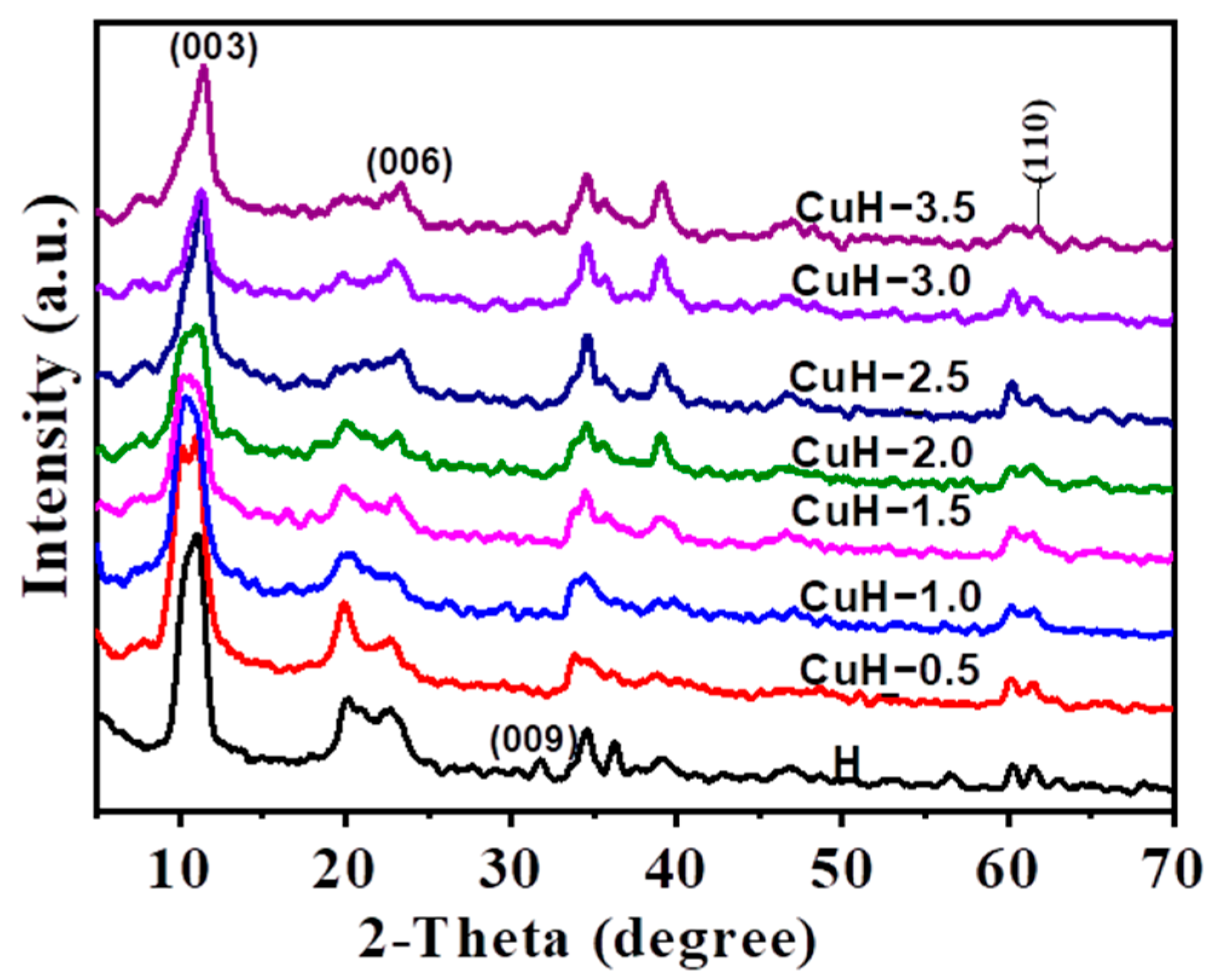
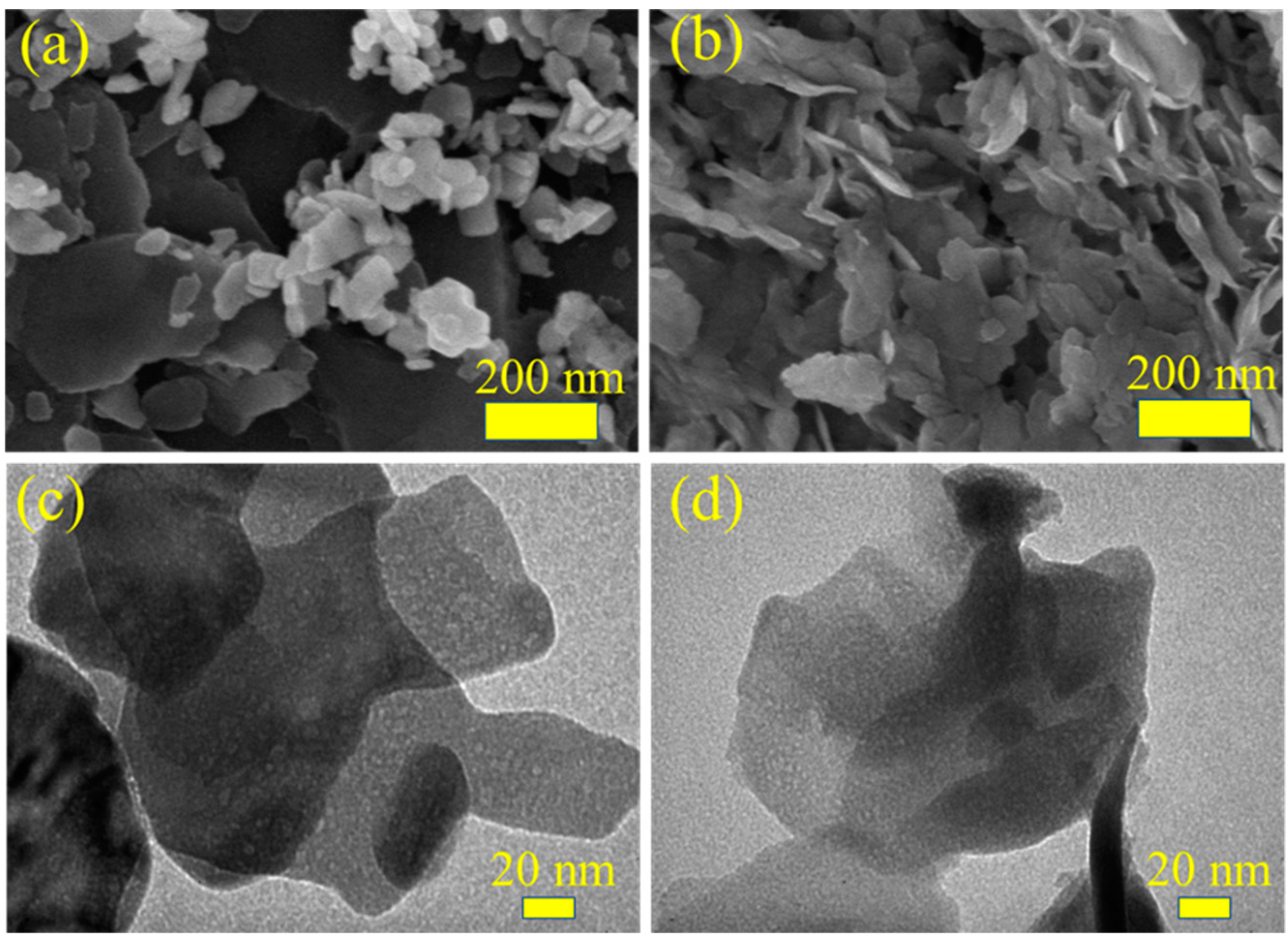
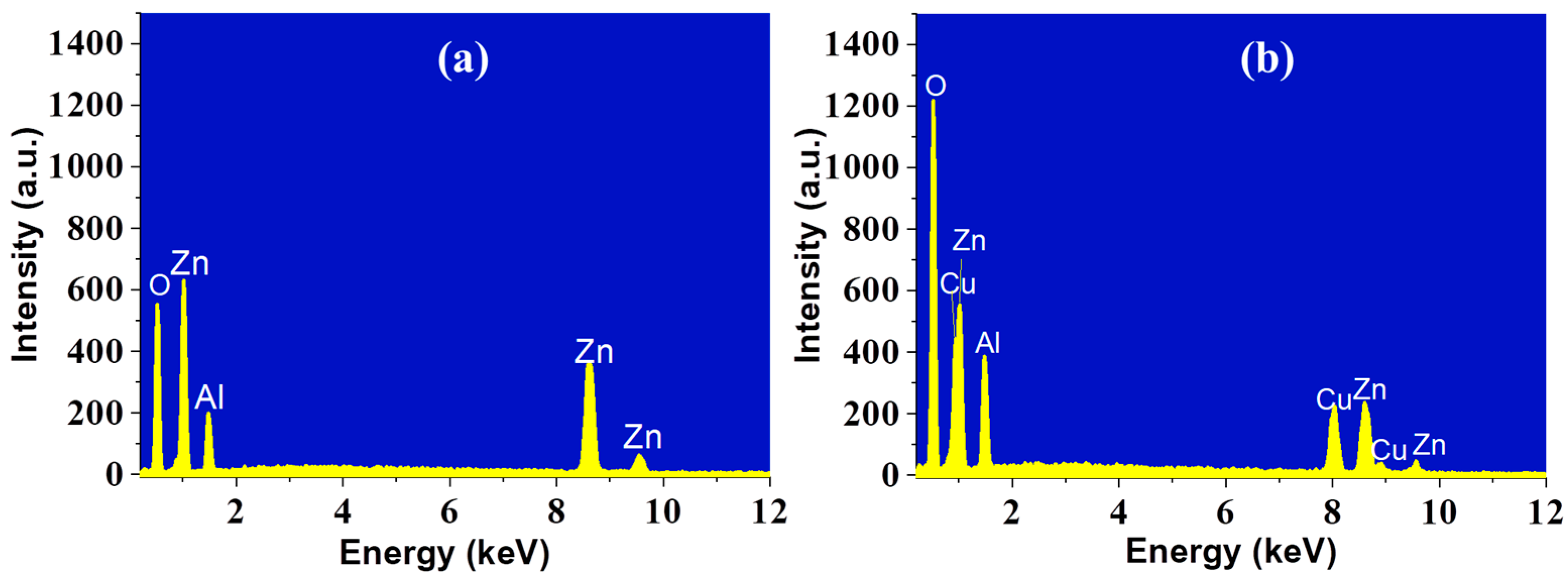
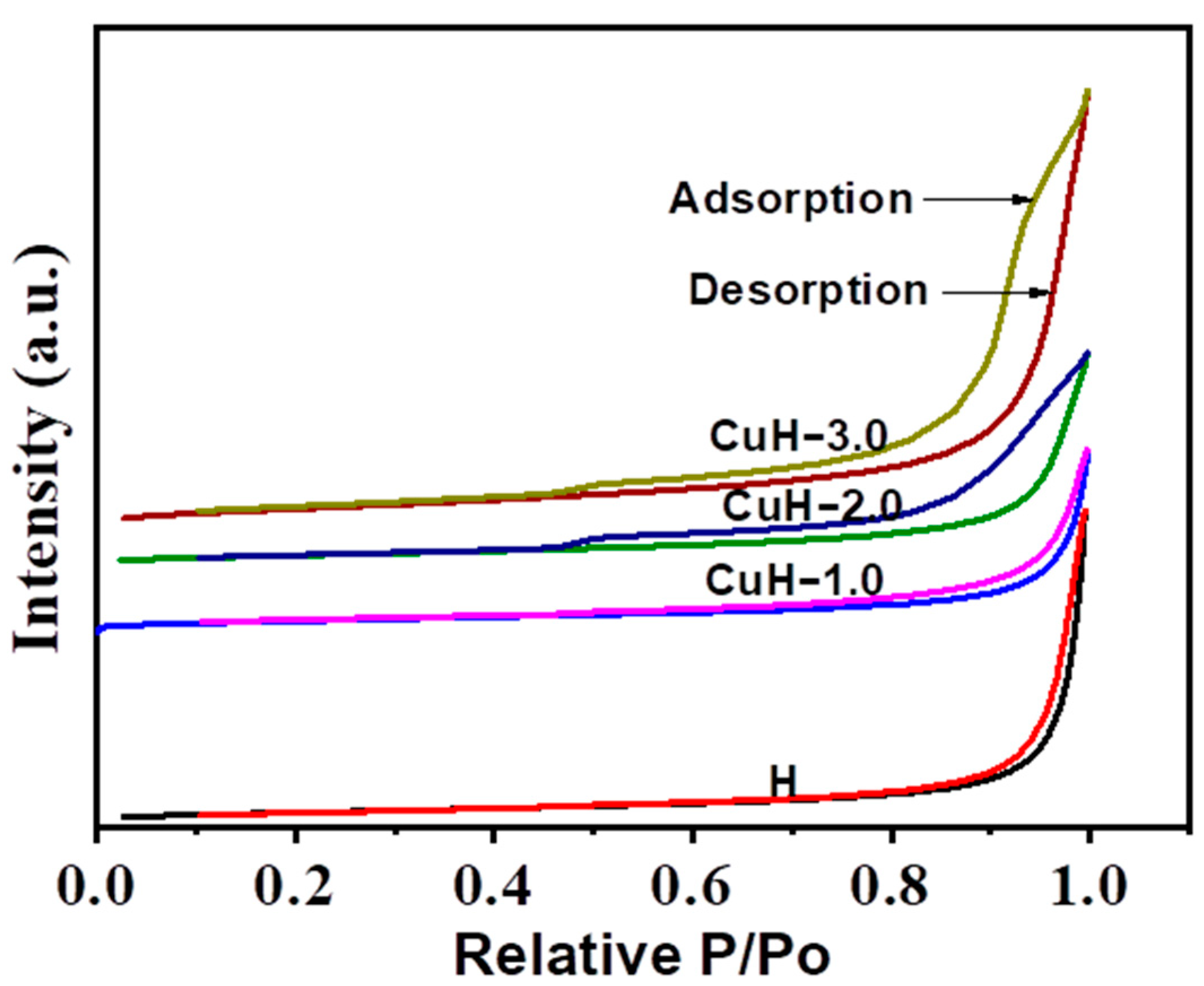

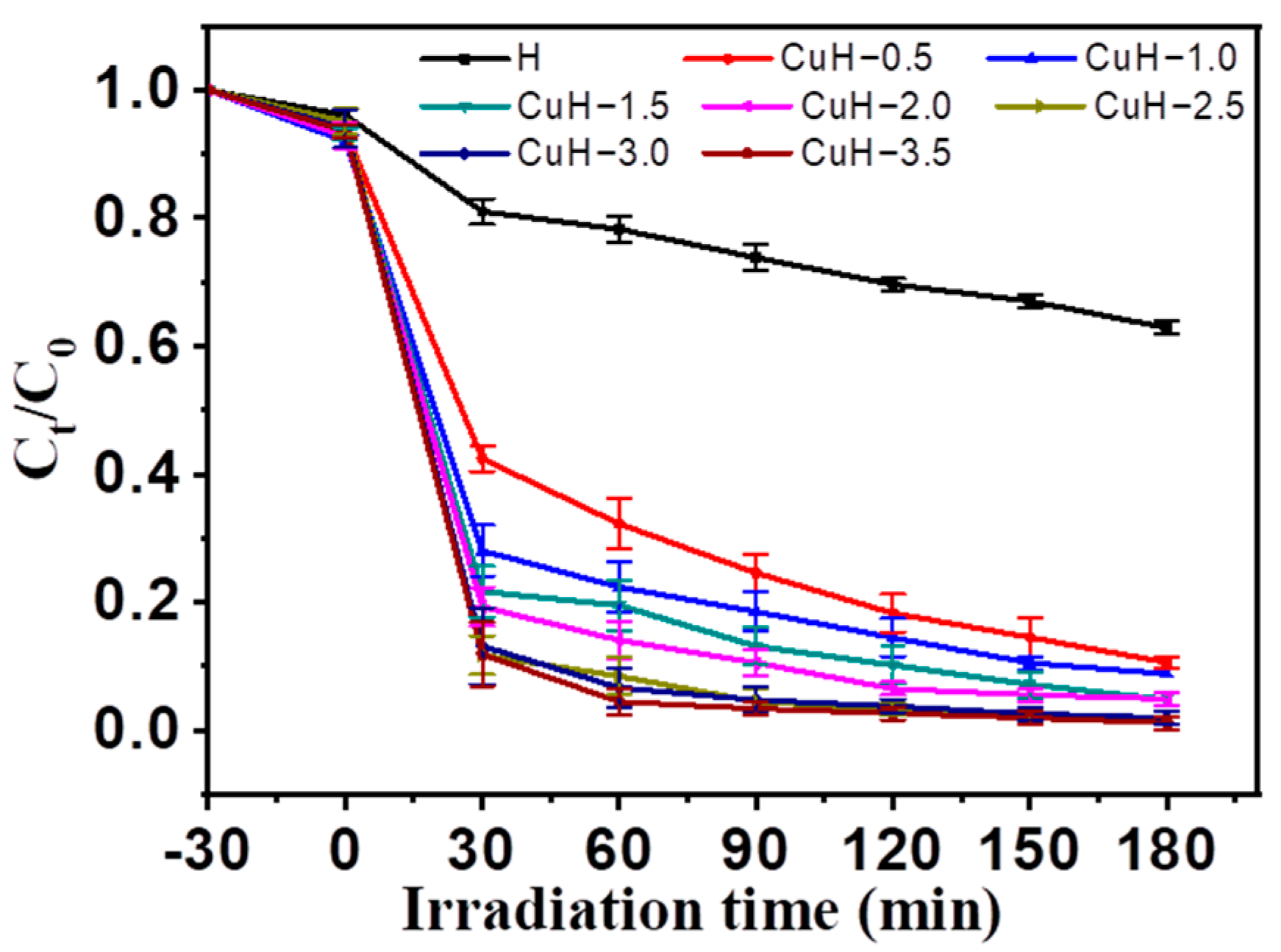
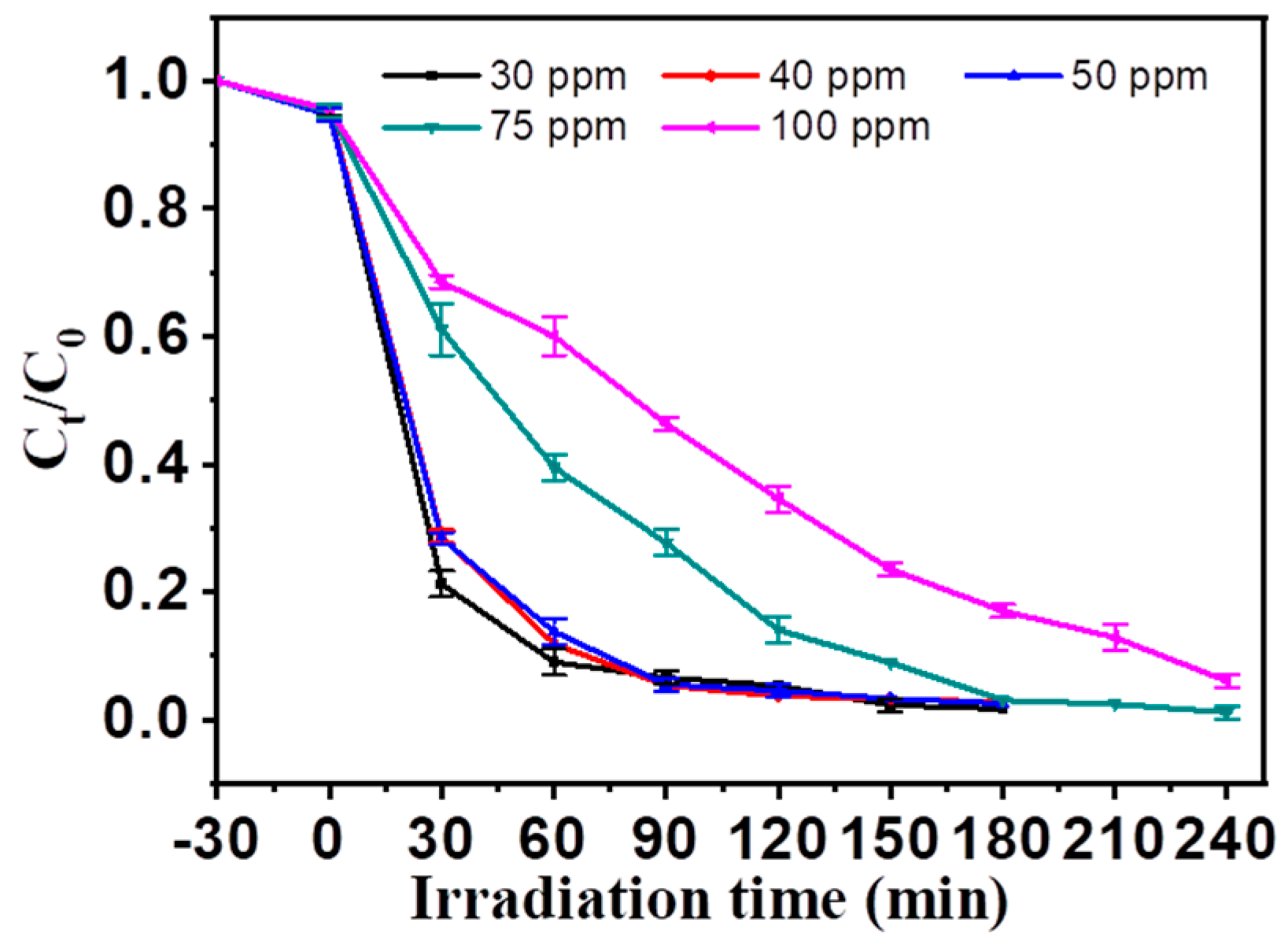

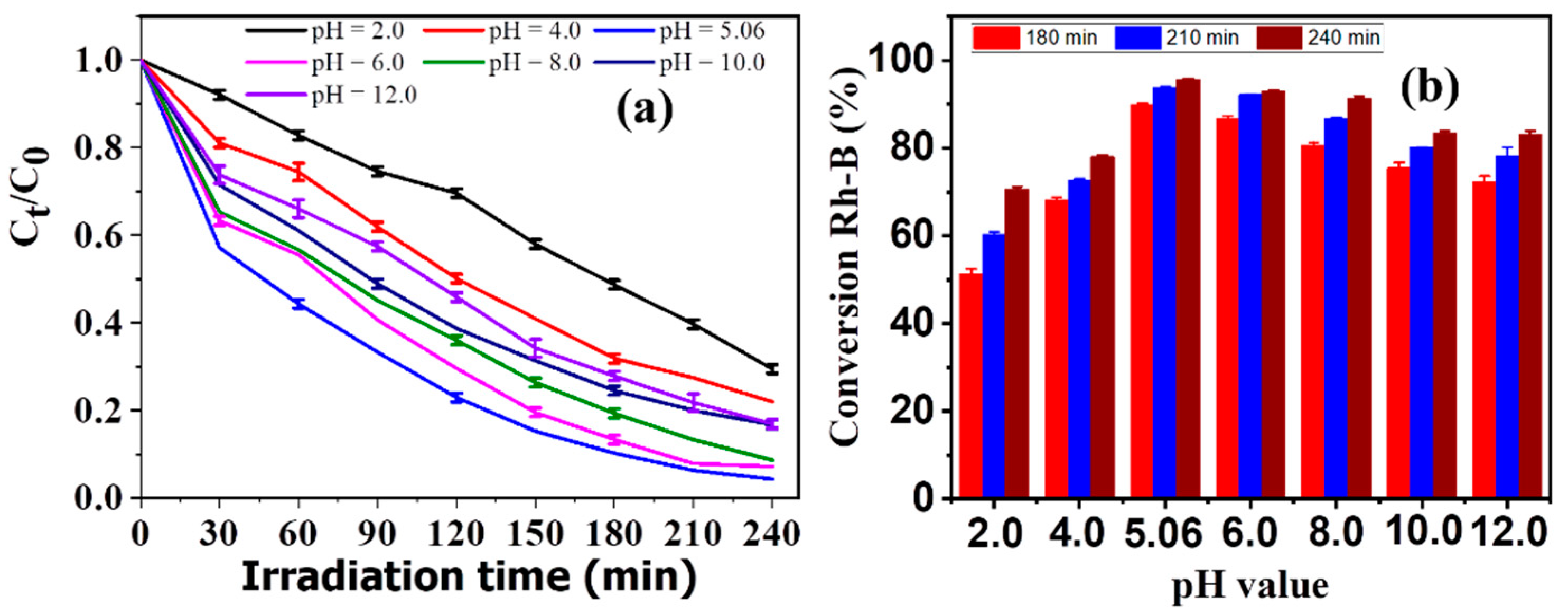

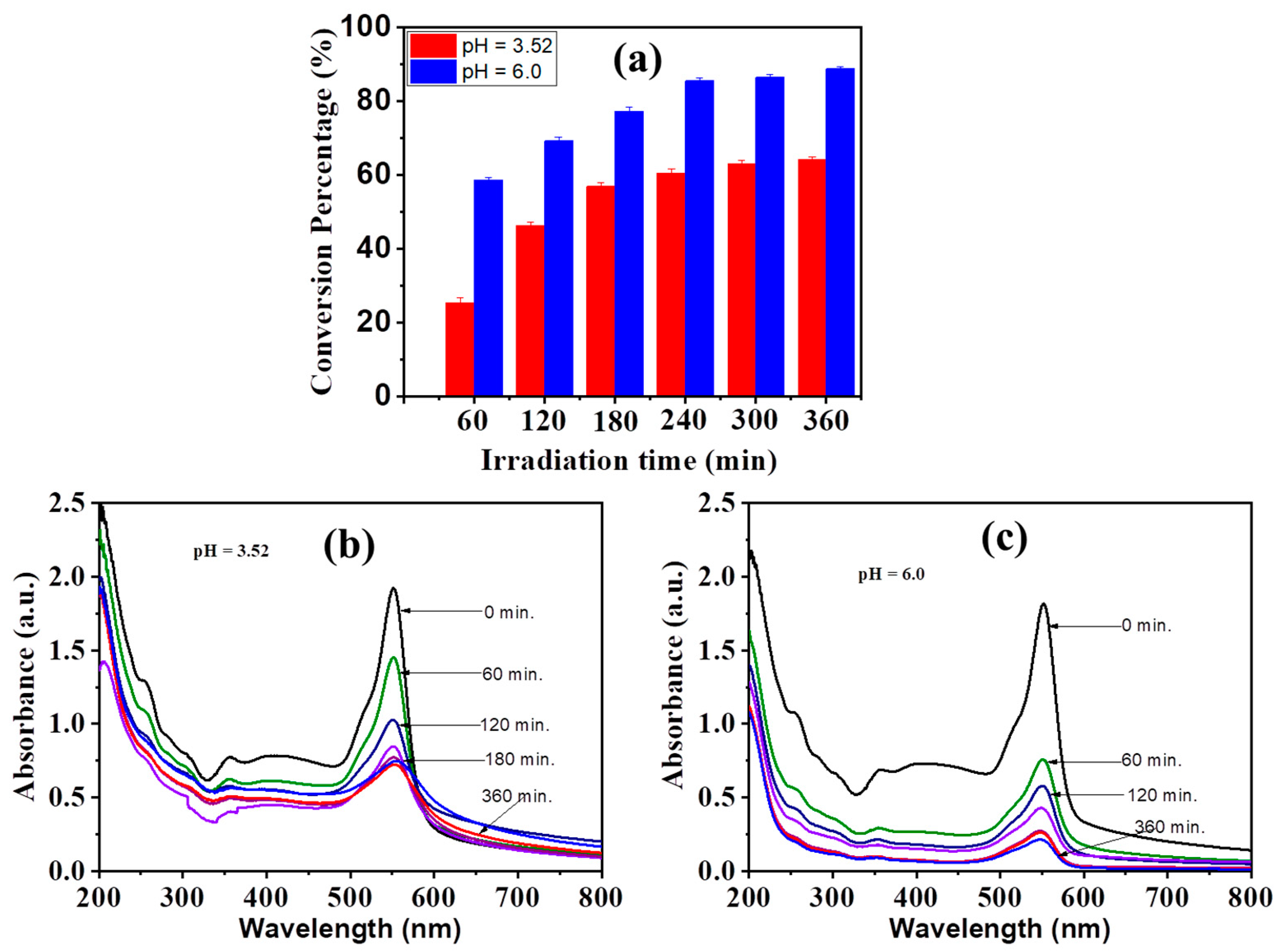

| Samples | % O Atom | % Al Atom | % Cu Atom | % Zn Atom |
|---|---|---|---|---|
| H | 72.19 | 8.94 | 0 | 18.87 |
| CuH-3.0 | 79.04 | 8.78 | 5.32 | 6.86 |
| Sample | Surface Area BET (m2/g) | Porous Diameter (nm) | Porous Volume (cm3/g) |
|---|---|---|---|
| H | 16.1 | 37.6 | 0.15 |
| CuH-1.0 | 15.7 | 21.1 | 0.08 |
| CuH-2.0 | 17.5 | 22.9 | 0.10 |
| CuH-3.0 | 33.9 | 24.5 | 0.21 |
| No. | Name | Molar Ratio Cu:Zn:Al:CO3 | d003 (Å) | d006 (Å) | d110 (Å) | Average Grain Size in Scherrer (nm) | Lattice Parameter (Å) | Color | |
|---|---|---|---|---|---|---|---|---|---|
| A | c | ||||||||
| 1 | H | 0:7.0:3.0:1.5 | 8.025 | 3.929 | 1.534 | 33.28 | 3.068 | 24.075 | White |
| 2 | CuH-0.5 | 0.5:6.5:3.0:1.5 | 8.027 | 3.913 | 1.537 | 18.64 | 3.074 | 24.081 | Light blue |
| 3 | CuH-1.0 | 1.0:6.0:3.0:1.5 | 8.559 | 3.866 | 1.536 | 20.31 | 3.072 | 25.677 | Light blue |
| 4 | CuH-1.5 | 1.5:5.5:3.0:1.5 | 8.051 | 3.854 | 1.535 | 17.96 | 3.07 | 24.153 | Black blue |
| 5 | CuH-2.0 | 2.0:5.0:3.0:1.5 | 7.963 | 3.841 | 1.537 | 15.09 | 3.074 | 23.889 | Black |
| 6 | CuH-2.5 | 2.5:4.5:3.0:1.5 | 7.806 | 3.812 | 1.536 | 21.20 | 3.072 | 23.418 | Black |
| 7 | CuH-3.0 | 3.0:4.0:3.0:1.5 | 7.824 | 3.868 | 1.535 | 16.09 | 3.07 | 23.472 | Black |
| 8 | CuH-3.5 | 3.5:3.5:3.0:1.5 | 7.726 | 3.808 | 1.529 | 19.02 | 3.058 | 23.178 | Black |
Publisher’s Note: MDPI stays neutral with regard to jurisdictional claims in published maps and institutional affiliations. |
© 2022 by the authors. Licensee MDPI, Basel, Switzerland. This article is an open access article distributed under the terms and conditions of the Creative Commons Attribution (CC BY) license (https://creativecommons.org/licenses/by/4.0/).
Share and Cite
Vu, V.N.; Pham, T.H.T.; Chanthavong, M.; Do, T.H.; Nguyen, T.H.L.; Nguyen, Q.D.; Tran, T.K.N. Enhanced Photocatalytic Degradation of Rhodamine-B under Led Light Using CuZnAl Hydrotalcite Synthesized by Co-Precipitation Technique. Inorganics 2022, 10, 89. https://doi.org/10.3390/inorganics10070089
Vu VN, Pham THT, Chanthavong M, Do TH, Nguyen THL, Nguyen QD, Tran TKN. Enhanced Photocatalytic Degradation of Rhodamine-B under Led Light Using CuZnAl Hydrotalcite Synthesized by Co-Precipitation Technique. Inorganics. 2022; 10(7):89. https://doi.org/10.3390/inorganics10070089
Chicago/Turabian StyleVu, Van Nhuong, Thi Ha Thanh Pham, Maiboun Chanthavong, Tra Huong Do, Thi Hien Lan Nguyen, Quoc Dung Nguyen, and Thi Kim Ngan Tran. 2022. "Enhanced Photocatalytic Degradation of Rhodamine-B under Led Light Using CuZnAl Hydrotalcite Synthesized by Co-Precipitation Technique" Inorganics 10, no. 7: 89. https://doi.org/10.3390/inorganics10070089
APA StyleVu, V. N., Pham, T. H. T., Chanthavong, M., Do, T. H., Nguyen, T. H. L., Nguyen, Q. D., & Tran, T. K. N. (2022). Enhanced Photocatalytic Degradation of Rhodamine-B under Led Light Using CuZnAl Hydrotalcite Synthesized by Co-Precipitation Technique. Inorganics, 10(7), 89. https://doi.org/10.3390/inorganics10070089






